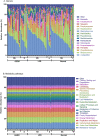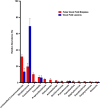The human laryngeal microbiome: effects of cigarette smoke and reflux
- PMID: 27775059
- PMCID: PMC5075886
- DOI: 10.1038/srep35882
The human laryngeal microbiome: effects of cigarette smoke and reflux
Abstract
Prolonged diffuse laryngeal inflammation from smoking and/or reflux is commonly diagnosed as chronic laryngitis and treated empirically with expensive drugs that have not proven effective. Shifts in microbiota have been associated with many inflammatory diseases, though little is known about how resident microbes may contribute to chronic laryngitis. We sought to characterize the core microbiota of disease-free human laryngeal tissue and to investigate shifts in microbial community membership associated with exposure to cigarette smoke and reflux. Using 454 pyrosequencing of the 16S rRNA gene, we compared bacterial communities of laryngeal tissue biopsies collected from 97 non-treatment-seeking volunteers based on reflux and smoking status. The core community was characterized by a highly abundant OTU within the family Comamonadaceae found in all laryngeal tissues. Smokers demonstrated less microbial diversity than nonsmokers, with differences in relative abundances of OTUs classified as Streptococcus, unclassified Comamonadaceae, Cloacibacterium, and Helicobacter. Reflux status did not affect microbial diversity nor community structure nor composition. Comparison of healthy laryngeal microbial communities to benign vocal fold disease samples revealed greater abundance of Streptococcus in benign vocal fold disease suggesting that mucosal dominance by Streptococcus may be a factor in disease etiology.
Figures


 Smokers (Normal, LPR, GERD);
Smokers (Normal, LPR, GERD);  Nonsmokers (Normal, LPR, GERD).
Nonsmokers (Normal, LPR, GERD).
 False Vocal Fold Biopsies;
False Vocal Fold Biopsies;  Vocal Fold Lesions (Reinke’s edema, cyst, nodule, polyp).
Vocal Fold Lesions (Reinke’s edema, cyst, nodule, polyp).


Similar articles
-
Composition and abundance of microbiota in the pharynx in patients with laryngeal carcinoma and vocal cord polyps.J Microbiol. 2017 Aug;55(8):648-654. doi: 10.1007/s12275-017-6636-8. Epub 2017 Jul 28. J Microbiol. 2017. PMID: 28752291
-
Alterations of microbiota structure in the larynx relevant to laryngeal carcinoma.Sci Rep. 2017 Jul 14;7(1):5507. doi: 10.1038/s41598-017-05576-7. Sci Rep. 2017. PMID: 28710395 Free PMC article.
-
High throughput sequencing reveals distinct microbial populations within the mucosal and luminal niches in healthy individuals.Gut Microbes. 2015;6(3):173-81. doi: 10.1080/19490976.2015.1044711. Gut Microbes. 2015. PMID: 25915459 Free PMC article.
-
The effect of cigarette smoking on the oral and nasal microbiota.Microbiome. 2017 Jan 17;5(1):3. doi: 10.1186/s40168-016-0226-6. Microbiome. 2017. PMID: 28095925 Free PMC article.
-
The quest for absolute abundance: The use of internal standards for DNA-based community ecology.Mol Ecol Resour. 2021 Jan;21(1):30-43. doi: 10.1111/1755-0998.13247. Epub 2020 Sep 17. Mol Ecol Resour. 2021. PMID: 32889760 Review.
Cited by
-
Altered Middle Ear Microbiome in Children With Chronic Otitis Media With Effusion and Respiratory Illnesses.Front Cell Infect Microbiol. 2019 Oct 4;9:339. doi: 10.3389/fcimb.2019.00339. eCollection 2019. Front Cell Infect Microbiol. 2019. PMID: 31637220 Free PMC article.
-
An Updated Review of Subglottic Stenosis: Etiology, Evaluation, and Management.Curr Pulmonol Rep. 2022;11(2):29-38. doi: 10.1007/s13665-022-00286-6. Epub 2022 Mar 3. Curr Pulmonol Rep. 2022. PMID: 35261874 Free PMC article. Review.
-
Factors Associated With Infectious Laryngitis: A Retrospective Review of 15 Cases.Ann Otol Rhinol Laryngol. 2017 May;126(5):388-395. doi: 10.1177/0003489417694911. Epub 2017 Feb 1. Ann Otol Rhinol Laryngol. 2017. PMID: 28397557 Free PMC article.
-
Single-cell view into the role of microbiota shaping host immunity in the larynx.iScience. 2024 May 31;27(6):110156. doi: 10.1016/j.isci.2024.110156. eCollection 2024 Jun 21. iScience. 2024. PMID: 38974468 Free PMC article.
-
Integrating the microbiota of the respiratory tract with the unified airway model.Respir Med. 2017 May;126:68-74. doi: 10.1016/j.rmed.2017.03.019. Epub 2017 Mar 22. Respir Med. 2017. PMID: 28427552 Free PMC article. Review.
References
-
- Koufman J. A. The otolaryngologic manifestations of gastroesophageal reflux disease (GERD): a clinical investigation of 225 patients using ambulatory 24-hour pH monitoring and an experimental investigation of the role of acid and pepsin in the development of laryngeal injury. Laryngoscope 101, 1–78 (1991). - PubMed
-
- Yonekawa H. A clinical study of Reinke’s edema. Auris Nasus Larynx 15, 57–78 (1988). - PubMed
-
- Jackson-Menaldi C. A., Dzul A. I. & Holland R. W. Allergies and vocal fold edema: a preliminary report. J Voice 13, 113–122 (1999). - PubMed
Publication types
MeSH terms
Substances
Grants and funding
LinkOut - more resources
Full Text Sources
Other Literature Sources

